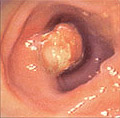Colonic polyp
| Colonic polyp | |
|---|---|
| Colonic polyp | |
| ICD-9 | V12.72 |
| OMIM | 175100 |
| MeSH | D003111 |
In medicine, colonic polyps are "discrete tissue masses that protrude into the lumen of the colon. These polyps are connected to the wall of the colon either by a stalk, pedunculus, or by a broad base."[1]
Classification
In a study of 2531 volunteers 50 years of age or older:[2]
- 1629 (64%) had no polyps
- 902 (36%) had polyps
- 512 (57% of the 902) had polyps with the largest being less than 5 mm in size
- 258 (29% of the 902) had 392 polyps with the largest being 5 mm - 9 mm in size
- 246 (63% of the 392 polyps) were adenomatous
- 146 (27% of the 392 polyps) were non-adenomatous such as hyperplastic polyps and lipomas
- 132 (15% of the 902) had 155 polyps with the largest being 10 mm or larger in size
- 121 (78% of the 155 polyps) were adenomatous
- 7 (5% of the 155 polyps) were carcinomas
- 27 (17% of the 155 polyps) were non-adenomatous
Hyperplastic polpys
Adenomatous polyps
Adenomatous colonic polyps are common and are present in 25% of men and 15% of women undergoing screening colonoscopy.[3]
- Tubular adenomas
- Tubulovillous adenomas
- Villous adenomas
Prognosis
| Polyp size | Cancer % (confidence interval) |
Villous histology or high-grade dysplasia % (confidence interval) |
Total % (confidence interval) |
|---|---|---|---|
| < 4 mm | 0 (0–.36) | 1.68 (.87–2.49) | 1.68 (.87–2.49) |
| 5–9 mm | 0.87% (.26–1.48) | 9.23 (7.32–11.14) | 10.10 (8.11–12.08) |
| > 10 mm | 5% |
Adenomatous colonic polyps may progress to colorectal cancer; however, less than 10% do so.[3] The rate of progression to invasive cancer among polyps of at least 10 mm size is about 1% per year.[5]
High risk colonic polyps are defined as either:[6]
- 3 or more synchronous adenomas
- Adenomas ≥1 cm in diameter
- Villous histology or high-grade dysplasia
The risk of current dysplasia depends on the size of the polyp (see table).[4] Similar numbers have been reported by other studies.[7] The risk of recurrence of future high risk histology is also correlated with size.[8]
Screening
A clinical practice guideline jointly written by the American Cancer Society and other groups recommends one of:[9]
- Flexible sigmoidoscopy every 5 years
- Barium enema every 5 years
- Virtual colonography (a noninvasive test based on computed tomography) every 5 years
- Colonoscopy every 10 years
When polyps are found, a clinical practice guideline jointly written by the American Cancer Society and other groups states:[6]
- High risk polyps are 1) 3 or more synchronous adenomas, 2) adenomas ≥1 cm in diameter, or 3) villous histology or high-grade dysplasia.
- High risk polyps should have follow-up colonoscopy in 3 years
- Low risk polyps should have repeat colonoscopy in 5 to 10 years
- If no adenomas are found, follow-up evaluation should be at 10 years
A validation of these guidelines found:[8]
- High risk adenomas - 9% of an advanced adenoma at 4 years of follow-up.
- Low risk adenomas - 5% of an advanced adenoma at 4 years of follow-up.
Thus, the criteria for high risk identified 60% of the subsequent high risk recurrences.
References
- ↑ Anonymous (2025), Colonic polyp (English). Medical Subject Headings. U.S. National Library of Medicine.
- ↑ 2.0 2.1 Johnson CD, Chen MH, Toledano AY, et al (September 2008). "Accuracy of CT colonography for detection of large adenomas and cancers". The New England journal of medicine 359 (12): 1207–17. DOI:10.1056/NEJMoa0800996. PMID 18799557. Research Blogging.
- ↑ 3.0 3.1 Levine JS, Ahnen DJ (December 2006). "Clinical practice. Adenomatous polyps of the colon". The New England journal of medicine 355 (24): 2551–7. DOI:10.1056/NEJMcp063038. PMID 17167138. Research Blogging.
- ↑ 4.0 4.1 Butterly LF, Chase MP, Pohl H, Fiarman GS (March 2006). "Prevalence of clinically important histology in small adenomas". Clinical gastroenterology and hepatology : the official clinical practice journal of the American Gastroenterological Association 4 (3): 343–8. DOI:10.1016/j.cgh.2005.12.021. PMID 16527698. Research Blogging.
- ↑ Stryker SJ, Wolff BG, Culp CE, Libbe SD, Ilstrup DM, MacCarty RL (November 1987). "Natural history of untreated colonic polyps". Gastroenterology 93 (5): 1009–13. PMID 3653628. [e]
- ↑ 6.0 6.1 Winawer SJ, Zauber AG, Fletcher RH, et al (May 2006). "Guidelines for colonoscopy surveillance after polypectomy: a consensus update by the US Multi-Society Task Force on Colorectal Cancer and the American Cancer Society". Gastroenterology 130 (6): 1872–85. DOI:10.1053/j.gastro.2006.03.012. PMID 16697750. Research Blogging.
- ↑ Pickhardt PJ, Hassan C, Laghi A, et al (November 2008). "Clinical management of small (6- to 9-mm) polyps detected at screening CT colonography: a cost-effectiveness analysis". AJR Am J Roentgenol 191 (5): 1509–16. DOI:10.2214/AJR.08.1010. PMID 18941093. Research Blogging.
- ↑ 8.0 8.1 Laiyemo AO, Murphy G, Albert PS, et al (March 2008). "Postpolypectomy colonoscopy surveillance guidelines: predictive accuracy for advanced adenoma at 4 years". Ann. Intern. Med. 148 (6): 419–26. PMID 18347350. [e]
- ↑ Levin, B., Lieberman, D. A., McFarland, B., Smith, R. A., Brooks, D., Andrews, K. S., et al. (2008). Screening and surveillance for the early detection of colorectal cancer and adenomatous polyps, 2008: a joint guideline from the American Cancer Society, the US Multi-society Task Force on Colorectal Cancer, and the American College of Radiology. CA Cancer J Clin, CA.2007.0018. DOI:10.3322/CA.2007.0018.
